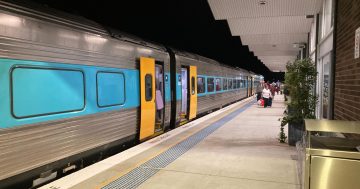
Queanbeyan and Palerang Council Cr Kenrick Winchester and Chief Minister Andrew Barr discuss the rail possibilities for the Canberra region at Canberra Railway Station. Photo: Ian Bushnell.
A redeveloped Canberra Railway Station and faster train travel to Sydney are a step closer after the NSW Government came on board to back ACT Labor’s plans for urban renewal in East Lake and agreed to set up a working group to reduce travel times on the popular route.
Chief Minister Andrew Barr, announcing the initiatives at the NSW-owned station with Queanbeyan and Palerang Council Cr Kenrick Winchester, said the decision by NSW Premier Chris Minns to support the station redevelopment and long called for works to cut the travel time to Sydney under four hours was significant.
Mr Minns said in a statement that the rail route between Canberra and Sydney was a critical line connecting families, workers and businesses across the state and territory.
“But we know it needs to be improved,” he said.
“That’s why we’re working with the ACT Labor Government to investigate key areas for improvement that would provide more reliable and faster journeys for commuters travelling between Canberra and Sydney.”
The backing comes after the East Lake Place Plan and its planning changes came into force last Friday, in which the transformation of the railway station into a multi-modal transport hub is a key part of a multi-level residential, retail and commercial precinct.
Mr Barr said that while there had been support for various improvements to the station and the line to Sydney before, this time, it came from the top.
He said NSW would not be investing in the redevelopment itself, which would proceed as a public-private partnership funded by land releases, the first of which is slated for 2025-26.
“This announcement today is a very big contribution to more housing supply to more economic activity and to better utilise land that is really proximal to existing services,” Mr Barr said.
He said the NSW Government would need to decide whether it still wanted to lease and operate the station in that context.
“They are doing these sorts of station redevelopment projects at considerable volume within their own state already, so they bring a lot of experience to the table on how to undertake these sorts of transit-oriented redevelopment,” Mr Barr said

The NSW TrainLink Southern XPLORER train at Canberra Station. More than 280,000 journeys have been made on the NSW TrainLink service in and out of Canberra in the past 12 months. Photo: John Coleman
Mr Barr said the 1960s station did not reflect the modern national capital or the growing patronage on the route, saying the site must be transformed to provide a greater sense of arrival and be fully connected with the existing city transport network.
He said that despite the four-hour trip, the three services to Sydney were heavily booked, and more than 280,000 journeys were made on the NSW TrainLink service in and out of Canberra in the past 12 months.
If the journey time could be reduced to three hours and be competitive with air and road travel, demand would grow, and more services or seats would be added, he said.
“The New South Wales Government is procuring new trains to support their intercity and regional services, but we do know that track work and the question of more express services, so fewer stops along the way, are necessary to reduce the travel time,” he said.
“But what I am convinced of is that there is an appetite for this. Of all of the major Australian cities, Canberra and Sydney are the most likely to be able to be viable train-serviced cities.”
Mr Barr said the Commonwealth was already considering a proposal that would contribute to improving the line, which would be welcome.
“The Premier has made clear in his statement today that he intends to join with me to work with the Federal Government on the project,” he said.
Cr Winchester said a faster service between Canberra and Sydney would be popular with people in the region.
“There’s a hell of a lot of people that live in NSW between the ACT and Sydney that will all benefit from a faster service,” he said.
Cr Winchester said people from Queanbeyan would jump at the chance to ride a three-hour train to Sydney, even if they had to board in Canberra.
“People from Bungendore or Tarago will happily go to either Canberra or Goulburn to jump on,” he said, “so it’s going to be popular.”
The working group would be looking at bus connections with the smaller towns and there might even be a free service from Queanbeyan station to Canberra.
East Lake is expected to be delivered over decades and could have an eventual population of 9000 and a workforce of 3000, with buildings ranging from four to eight storeys.




















